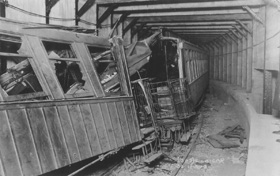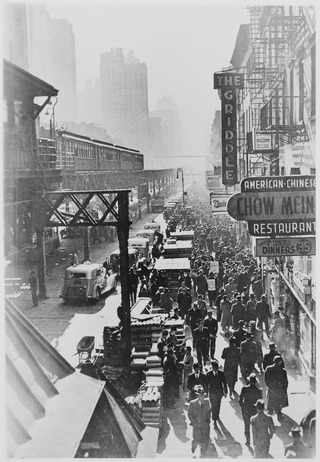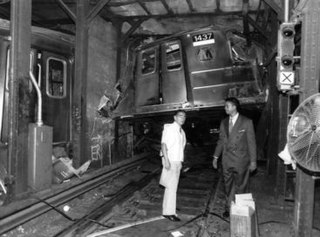
The Malbone Street wreck, also known as the Brighton Beach Line accident, was a rapid transit railroad accident that occurred on November 1, 1918, on the New York City Subway's BMT Brighton Line in the Flatbush neighborhood of Brooklyn in New York City. A speeding train derailed in the sharply curved tunnel beneath Willink Plaza, the intersection of Flatbush Avenue, Ocean Avenue, and Malbone Street. At least 93 people died, making it the second-deadliest train crash in American history, as well as the deadliest crash in the history of the New York City Subway.

The Interborough Rapid Transit Company (IRT) was the private operator of New York City's original underground subway line that opened in 1904, as well as earlier elevated railways and additional rapid transit lines in New York City. The IRT was purchased by the city in June 1940, along with the younger BMT and IND systems, to form the modern New York City Subway. The former IRT lines are now the A Division or IRT Division of the Subway.

The Green Line is a rapid transit line in Chicago, Illinois, operated by the Chicago Transit Authority (CTA) as part of the Chicago "L" system. It is the only completely elevated route in the "L" system. All other routes may have various combinations of elevated, subway, street level, or freeway median sections.

The West Farms Square–East Tremont Avenue station is a local station on the IRT White Plains Road Line of the New York City Subway. Located at the intersection of East Tremont Avenue and Boston Road in the West Farms neighborhood of the Bronx, it is served by the 2 train at all times, and the 5 train at all times except late nights and rush hours in the peak direction.

The Brighton Beach station is an elevated express and terminal station on the BMT Brighton Line of the New York City Subway. It is located over Brighton Beach Avenue between Brighton 5th Street and Brighton 7th Street in Brighton Beach, Brooklyn. The station is served by the Q train at all times and is the southern terminal for the B train on weekdays only.

The IRT Ninth Avenue Line, often called the Ninth Avenue Elevated or Ninth Avenue El, was the first elevated railway in New York City. It opened in July 1868 as the West Side and Yonkers Patent Railway, as an experimental single-track cable-powered elevated railway from Battery Place, at the south end of Manhattan Island, northward up Greenwich Street to Cortlandt Street. By 1879 the line was extended to the Harlem River at 155th Street. It was electrified and taken over by the Interborough Rapid Transit Company in 1903.

The New York City Subway is a rapid transit system that serves four of the five boroughs of New York City, New York: the Bronx, Brooklyn, Manhattan, and Queens. Its operator is the New York City Transit Authority (NYCTA), which is controlled by the Metropolitan Transportation Authority (MTA) of New York. In 2016, an average of 5.66 million passengers used the system daily, making it the busiest rapid transit system in the United States and the seventh busiest in the world.

The BMT Franklin Avenue Line is a rapid transit line of the New York City Subway in Brooklyn, New York, running between Franklin Avenue and Prospect Park. Service is full-time, and provided by the Franklin Avenue Shuttle. The line serves the neighborhoods of Bedford-Stuyvesant and Crown Heights, and allows for easy connections between the Fulton Street Line and the Brighton Line.

The Culver Shuttle was a New York City Subway shuttle, running along a remnant of the BMT Culver Line, most of which is now the IND Culver Line. The shuttle was originally part of the Brooklyn-Manhattan Transit Corporation (BMT)'s 5 service, providing through service on the Culver Line between Coney Island and Manhattan. The F train is the current successor to Culver Line service. The line had 1,000 riders a day during its final month of service in 1975.

The IRT Sixth Avenue Line, often called the Sixth Avenue Elevated or Sixth Avenue El, was the second elevated railway in Manhattan in New York City, following the Ninth Avenue Elevated.

The Shipyard Railway was an electric commuter rail/interurban line that served workers at the Richmond Shipyards in Richmond, California, United States, during World War II. It was funded by the United States Maritime Commission and was built and operated by the Key System, which already operated similar lines in the East Bay. The line ran from a pair of stations on the Emeryville/Oakland border – where transfer could be made to other Key System lines – northwest through Emeryville, Berkeley, Albany, and Richmond to the shipyards. It operated partially on city streets and partially on a dedicated right-of-way paralleling the Southern Pacific Railroad mainline.

The Sacramento Northern Railway was a 183-mile (295 km) electric interurban railway that connected Chico in northern California with Oakland via the California capital, Sacramento. In its operation it ran directly on the streets of Oakland, Sacramento, Yuba City, Chico, and Woodland and ran interurban passenger service until 1941 and freight service into the 1960s.

The Ninth Avenue station is a bi-level express station on the BMT West End Line of the New York City Subway, located at the intersection of Ninth Avenue and 39th Street in Brooklyn. Each level has three tracks and two island platforms. The upper level serves the BMT West End Line while the lower level formerly served the BMT Culver Line. Only the upper level is still in service and is served by the D train at all times.

York–Dauphin station is an elevated rapid transit station on the Market–Frankford Line, of the SEPTA transit system. It is located in the Kensington neighborhood of Philadelphia, Pennsylvania. The station is located at the intersection of Dauphin, Jasper, and Front Streets. it is the easternmost station running above Front Street; east of the station the line turns onto Kensington Avenue heading towards Frankford.

The 149th Street station was a station on the demolished IRT Third Avenue Line in the Bronx, New York City. It was located in "The Hub" in the South Bronx, at the intersection of 149th Street, Third Avenue, Willis Avenue, and Melrose Avenue. Opened as an express station in 1887 and later operating as the line's southern terminus, the station closed in 1973 and was demolished by 1977 due to political pressure in the area.
The 53rd Street and Eighth Avenue station was a station on the demolished IRT Sixth Avenue Line in Manhattan, New York City. It was built in 1881 by the Manhattan Railway Company as part of an effort to connect the northern end of the Sixth Avenue Line to the Ninth Avenue Line. It had three tracks and two side platforms, and was served by trains from the IRT Sixth Avenue Line. As a result, it became the last station on the Sixth Avenue Line before merging at a sharp curve with the Ninth Avenue Line. On September 11, 1905, 12 people were killed and 42 injured when a train jumped over the rails at the curve on 53rd Street between the Ninth Avenue 50th Street and 59th Street stations. In 1932, the Independent Subway System built the 50th Street Station three blocks to the south on the Eighth Avenue Subway with an additional lower level in 1933, thus rendering the elevated station and line obsolete. It closed on December 4, 1938. The next southbound stop was 50th Street. The next northbound stop was 59th Street.

The Tacoma Streetcar Disaster was a public transportation accident that took place in Tacoma, Washington, on July 4, 1900 when an overloaded streetcar failed to negotiate a curve and plunged down an embankment near a trestle that spans today's South Tacoma Way. The accident resulted in 43 deaths and approximately 65 injuries, many serious.
During the evening rush hour on August 24, 1928, an express subway train derailed immediately after leaving the Times Square station on the IRT Broadway–Seventh Avenue Line. Sixteen people were killed at the scene, two died later, and about 100 were injured. It remains the second-deadliest accident on the New York City Subway system, after the Malbone Street Wreck.

On August 28, 1991, a 4 Lexington Avenue Express train on the New York City Subway's IRT Lexington Avenue Line derailed as it was about to enter 14th Street–Union Square station, killing five people. It was the worst accident on the subway system since the 1928 Times Square derailment. The motorman was found at fault for alcohol intoxication and excessive speed, and served time in prison for manslaughter.




















